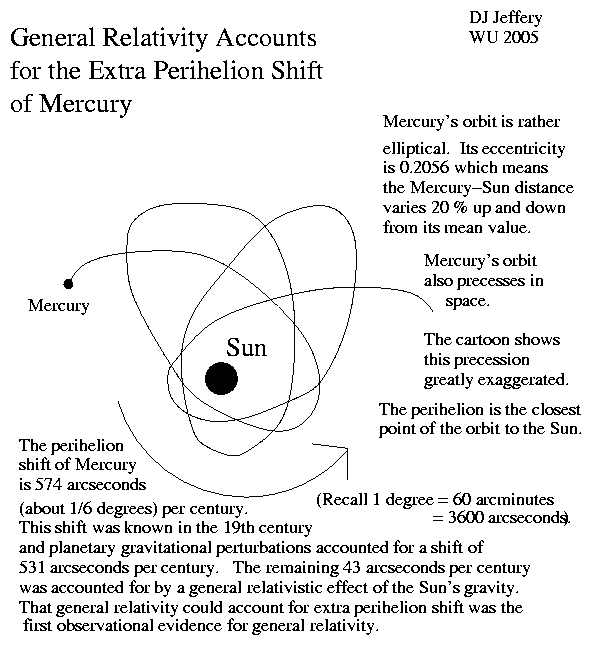
Caption: A cartoon illustrating the perihelion shift of Mercury.
Features:
- An exact Newtonian physics
gravitationally-bound
gavitational two-body system
would consist of 2 astronomical bodies
(assumed to be exactly
spherically symmetric)
orbiting
their mutual
center of mass
(AKA their barycenter)
in elliptical orbits
perpetually without change.
- Of course, the just-described
gavitational two-body system
is an ideal limit.
In reality,
astronomical perturbations
will always lead to
deviations for any
gavitational two-body system.
-
Mercury's orbit
(i.e., its elliptical orbit
about the Sun)
is an important special case of
the gavitational two-body system
for theoretical physics.
Note that the Sun's center is effectively
the barycenter in this case since
Mercury's mass M_☿
<< the Sun's M_☉.
The reason for the specialness of Mercury's orbit is that elliptical orbit undergoes an apsidal precession: the Mercurian perihelion precession 574.10(65)''/century = 0.15947°/century ≅ (1/6)°/century relative to the observable universe (more precisely the International Celestial Reference Frame") (see Wikipedia: Tests of general relativity: Perihelion precession of Mercury). This apsidal precession (or perihelion shift of Mercury) is mostly due to astronomical perturbations determinable from Newtonian physics. However, 43'' are NOT so determinable. This extra perihelion shift discrepancy was known in the 19th century.
- In the 19th century, people tried to solve the
extra perihelion shift
by postulating a
planet inward of
Mercury
that gave an extra
gravitational perturbation.
This hypothetical planet is NOT
the explanation of the
extra perihelion shift
(see below) and does NOT exist.
But it was given a name
Vulcan and
continues to live in legend---but it
doesn't exit (pace
Star Trek).
- In fact, the
extra perihelion shift
is due to an effect of
general relativity (GR).
GR dictates a force in addition
to Newtonian gravitation
(which is a 1/r**2 force or inverse-square law force).
The additional force varies as 1/r**4
and leads to an apsidal precession
(see
Wikipedia:
Two-body problem in general relativity: Effective radial potential energy).
In the Solar System, this additional GR force is overwhelmingly largest for orbit of Mercury (see Wikipedia: perihelion shift of Mercury) which we are discussing in this figure.
- Albert Einstein (1879--1955) himself in
1915
showed how general relativity
solved the problem of
perihelion shift of Mercury
using
perturbation theory
in GR, NOT by exact
analytic solution
(see Wikipedia: General relativity: History).
- In 1916,
Einstein
proposed 3
falsification tests
(which we now call the
classical tests
of general relativity:
- Explaining quantitatively perihelion shift of Mercury which was passed already in 1915 (see Wikipedia: General relativity: History).
- Predicting quantitatively the bending of light which we now call gravitational lensing. This predication was confirmed to good confidence in 1919 by the 1919 Solar Eclipse Expedition. See also 1919_solar_eclipse_expedition.html. Gravitational lensing has been confirmed many times since and nowadays to very high accuracy/precision.
- Predicting quantitatively the gravitational redshift of light. This prediction was first confirmed to good confidence by Pound-Rebka experiment (1959).
- General relativity
has nowadays been confirmed many times to very high confidence.
A couple of spectacular examples:
- Gravitational waves (a prediction of GR) were found indirectly in the 1970s via observations of the binary pulsar PSR B1913+16 and directly from GW150914: the first observation of gravitational waves (2015).
- The event horizon of a black hole (another prediction of GR) was first observed by Event Horizon Telescope (EHT) with observations of supermassive black hole M87* (at the center of galaxy M87) in 2019.
Currently (year 2020), general relativity is our best available theory of gravity and it has passed many falsification tests and failed none. It may well be the true emergent theory of gravity at the macroscopic scale: i.e., the macroscopic limit of quantum gravity---for which there is NO verified theory as of now.
Credit/Permission: © David Jeffery, 2005 / Own work.
Image link: Itself.
Local file: local link: mercury_perihelion_shift.html.
File: Relativity file: mercury_perihelion_shift.html.